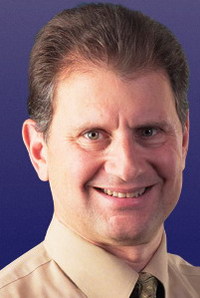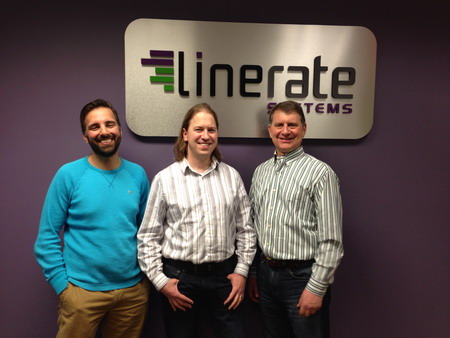Monday, February 11, 2013
How LineRate Systems' Funding Turned Into An Exit

How did working on a second round of funding turn into a huge exit for Louisville's LineRate Systems (www.lineratesystems.com)? Steve Georgis, CEO of LineRate, sat down with us today to tell us about the company's rise from the research out of the University of Colorado at Boulder, to its exit and acquisition this morning by networking equipment firm F5. Steve tells us that the acquisition--which he says was the highest value acquisition price of a tech startup here in the last five years--came as an accident of its quest for a second round of institutional funding.
Let's start at the top, for those who aren't familiar with what LineRate does?

Steve Georgis: What LineRate is doing, is we're really the performance leader in what is called application layer, software defined networking. It's commonly called SDN. IN general, SDN is a big, new disruptive theme that is starting to get traction with large data center customers, be they enterprise, web, or social media type customers, and more recently, telecom and communications service providers. The whole idea is to provide virtualization and agility, and ability to scale on demand in your infrastructure and services. At LineRate, we are focused on the application layer, commonly called Layer 7 in the OSI stack, the top layer. We're the layer most closely related to algorithms, the Web, software-as-a-service, and applications.
That application layer networking is largely used to do things like manage traffic, enforce policies, and particularly subscriber policies in communications services and software-as-a-service, so that you are able to do very high level networking functions that occur very closely to the application.
How did the company start?
Steve Georgis: Our genesis began with two researchers, John Giacomoni and Manish Vachharajani, at the University of Colorado's Computer Science Department. What they did, is they solved how to do this high performance, application layer purely in software. Before that, the technology required to do this was always hardware based technology. From that original intellectual property, the company was formed, spun out of the university, and that was the genesis of LineRate Systems. I became the CEO here in 2010, and I myself was a serial entrepreneur in the Boulder are for the past 25 years, and co-founded notable companies like Exabyte, Network Photonics, and most recently Prostor, and now LineRate.

(From left to right: Linerate's Manish Vachharajani, John Giacomoni, and Steve Georgis)
Did you join with the investment round?
Steve Georgis: I joined before. I was part of the angel group that made the initial investment, and ultimately became CEO, and brought in Boulder Ventures as our first institutional round. Historically, the company was seeded by a professional angel group here, a set of individuals who are professional investors, and former tech CEOS. They're basically successful entrepreneurs who understood the value that LineRate could offer to the marketplace. That initial seed funding was followed in 2011 by our first institutional venture capital financing, by Boulder Ventures. The thing to note from our investment, is it was all done here locally in Boulder County. This was actually a huge home run for the investors. I can't talk about the deal terms of acquisition price, but I can say it was the highest value acquisition price of a technology startup in the last five years here.
How did the acquisition came about?
Steve Georgis: We were in the process of raising our initial round of financing. In that process, we had met the F5 team, who took interest in what we were doing. What we were doing, is the evolution of where the market is going. In the market, F5 is the worldwide market leader, and what we were doing represented the next step in technology, particularly as people move towards a software defined data center. We had begun talking with investors, both venture capitalists as well as strategic investors. As part of that, we got to know F5, and it became very clear that we had lots of interest in common. Ultimately, F5 stepped in rapidly to make the acquisition, head of us closing our next institutional round of financing.
Was it tough to decide to go from funding to instead an exit?
Steve Georgis: It was tough to decide whether to exit or continue. But, I would say, in working with F5, we found we had a common vision of the market, and our company was well positioned to execute on the technology. We had a very similar culture, so as we started talking about a merger, and getting to know each other, it felt very natural. It was very interested. It felt like we belonged together. It wasn't difficult at all, and once we decided we wanted to do this, it came together rapidly. We weren't shopping the company, and we were not trying to sell, we were just working to raise our next round of capital. But, then we saw this opportunity, and its very attractive acquisition price. It was really a home run for our investors, and it became very clear to us what direction we should choose.
Now that you've been acquired, are you planning on staying in area and growing?
Steve Georgis: The answer is yes. One of the things, besides our technology that F5 finds attractive, is the ability to have a presence in the Boulder/Denver area, to tap into essentially a whole new talent pool. What we've been able to demonstrate, is there is a very rich talent pool locally. Most companies who are not here are largely unaware of this. People on the west coast are killing each other for talent. But, we've been able ot assemble a world class team without much competition. That's a very attractive thing. We get to stay exactly where we are, and F5 will be investing locally to grow this operation.
Thanks, and congratulations on the acquisition!